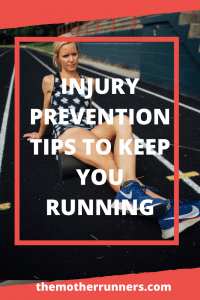We’ve all been there. You go for a run, everything feels fine—and then you wake up with a weird ache somewhere in your body. It may be under your knee cap or in your hamstring or in the arch of your foot. And, if you’re like me, you start the panic. Crap.
Is this going to be a running injury? Where did this pain come from? Is it going to sideline my goals? You start googling and every post seems to point to “yes”—yes, it will most definitely force you to take time off running for at least six weeks. How will you survive?!
Related: Expert tips to diagnose & prevent running injuries

These little pains, or what many runners call “niggles”, is your body telling you that you need to pay more attention to how you are caring for yourself. (Take note, niggles are different than excruciating pain that can signify a big-time running injury).
They aren’t the death knell for your training. All too often I let niggles freak me out or turn into something bigger—like a torn hamstring that still haunts me months later.
Here is a method I learned from my elite runner friend to nip niggles in the bud. It’s worked for me countless times and many of my Mother Runner friends on potential running injuries. Hopefully, it will work for you, too.
Ice & Heat Your Injury.
Icing an acute, not chronic injury like tendonitis, will decrease localized inflammation and calm the area down. Now, I know us mamas don’t have much time to sit around for 15-20 minutes. So, buy an ace bandage, strap on that ice pack and go about your business. Just don’t forget you have the ice pack on. I did that earlier this year and frostbit my heel. It wasn’t pretty. Set a timer for 20 minutes. And keep it up—multiple times a day. And then follow each ice session with heat. I use a cloth bag filled with rice that I heat up for about a minute. If you are treating a chronic injury flare-up, heat is your best bet to increase blood flow and promote healing.
Foam Roll Your Injury.
This niggle is likely your body’s way of telling you that you need to tend to it better. No more running and then immediately heading back into Mom mode. Take some time to use a foam roller on main body parts including your legs and seat. (Do this before you head into the house so your kids don’t know you’re home yet). There is some evidence that foam rolling may aid recovery by increasing circulation necessary for healing (just like massage). This study found that a 20-minute session can decrease muscle soreness. Pay extra attention to the trouble spot which may be a little deceiving. By this I mean, knee pain may mean that your quads are too tight. Heel pain could mean your calves need some TLC. Be sure to roll out areas near where your niggle is. For arch and ball of foot pain, use a golf or lacrosse ball (or maybe a toy), step on it, and roll it around the foot for some relief. Doing this will provide some short-term pain relief.
(Check out how this ultra runner mom manages to run injury-free and strength training for runners to ward off injuries.)
Incorporate Strength Training.
In order to address the injured area, you need to strengthen in. Foam rolling, icing, and stretching may relieve the pain but it won’t fix the problem completely. You need to eradicate weaknesses so that you aren’t further irritating the area each time you run. Incorporate an eccentric loading routine into your recovery. Eccentric exercises strengthen your muscles and tendons as they lengthen and have been proven beneficial in treating tendon and muscle injuries. For example, hamstring sliders help hamstring injuries. Calf raises help Achilles tendinopathy and plantar fasciitis. Hip drops on a step help quadriceps injuries. You can get a specific exercise by asking a physical therapist, employing Dr. Google, or visiting this reputable site for running injuries, running-physio.com.

Stop Running.
Take two days off from running. You can do something else if you must—an exercise class, swimming, bike, or the elliptical if it doesn’t hurt. If you don’t want to miss a workout, you can plan to take this time near planned off days—just try to take it easy leading up to this break. An alternative is to try to run through the pain but back off on intensity to see if the niggle goes away. If it doesn’t, then you know for sure it’s time to rest.
Run Slow.
After your mini-break, start back super slow. Like minutes slower than your usual average pace. Your run back is a test run to see if you are feeling better. If you are, awesome! But still, tread lightly for the next couple days.
If you aren’t feeling better, then you may need to take a few more days off and keep up the TLC. Or, you may need to see a doctor or physical therapist. Whenever you are in doubt, rest is almost always better than running. Listen to your body. Don’t pull a Taylor Swift and try to “shake it off.” If your niggle is, in fact, an injury, you can use your time off from running to focus on the strength that will make you a stronger, better runner. Running will always be there for you.

Such nice ideas.. you have written it so well. Love this post!
Thanks for reading!